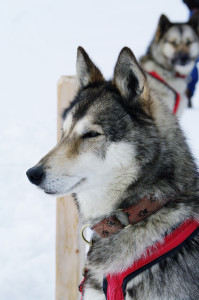
The Washington Post comments on research that notes that doggy gestures are just as important as human gestures in the dog world and could possibly reveal information about the evolution of human emotions.
Why do dogs bow down when they meet another dog and then jet off while the other dog runs after them they stop and repeat the process?
According to the article the doggy bow (play bow), when two dogs meet for the first time, is one of the most common used gestures in the dog world. It represents an instigation, a clarification, a warning and an apology depending on the context of its use. Dogs tend to display the “bow” pose as an invitation to engage in play as well as right before they nip another dog/human in a fooling around manner etc.
This is believed by many, especially Marc Bekoff, a professor at the University of Colorado, to illustrate that dogs have a moral code. Bekoff’s data obtained from many years of video footage of coyotes, dogs and wolves purports that such signals are important during play and without them a giddy tussle could quickly turn into a vicious fight.
“Play is a major expenditure of energy, and it can be dangerous. You can twist a shoulder or break a leg, and it can increase your chances of being preyed upon. So why do they do it? It has to feel good,” notes Bekoff.
In the wild, coyotes ostracize pack members that don’t play by the rules. Something similar happens in dog parks: If three dogs are playing and one bites or tackles too hard, the other two are likely to give him the cold shoulder and stop playing with him, Bekoff says. This suggests, according to Berkoff, that dogs do in fact display morality. This in turn begs the question, do dogs have emotions and what range of emotions do they have?
To have a moral code also implies that you have empathy, knowing how other does feel otherwise how could all dogs be held to the same standard (i.e. moral code). Having empathy implies that there are emotions as well you have to be able to understand how including or excluding another dog can prove effective if they don’t follow a certain code which is held to all dogs so that in turn hints at an understanding of equality as well.
Bekoff puts it much simpler, dogs must also be able to read the emotions in others, distinguishing accident from intent, honesty from deceit in order to decide to accept or ostracize a behavior.
He found that canines “role-reverse” or “self-handicap” during play. When a big dog played with a smaller one, for example, the big dog often rolled on her back to give the smaller dog an advantage, and she allowed the other dog to jump on her far more often than she jumped on him. Darwin was another observational biologist that also posited that canines were very intelligent and equipped with abstract thought, morality and language.
Play may seem a frivolous activity, but because it is not simply a survival reflex, it provides the best opportunity to explore who the animal really is. It reveals far more than just the emotional lives of the animals involved. It could ultimately shed light on the evolution of human emotions and how we came to build a civilization based on laws and cooperation, empathy and altruism.
Bekoff’s most recent work suggests another remarkable canine skill: the ability to know what another animal is thinking — a so-called “theory of mind.”